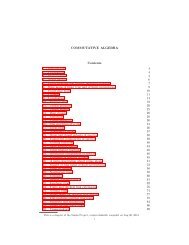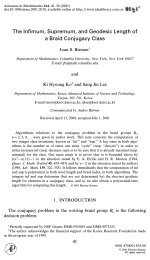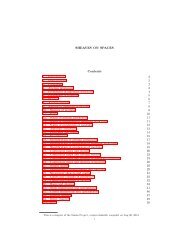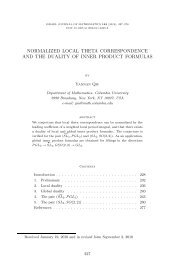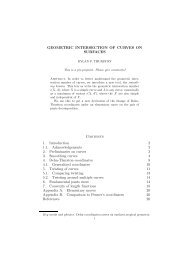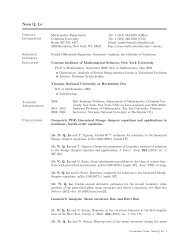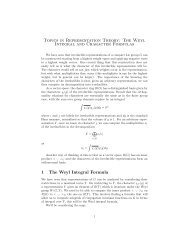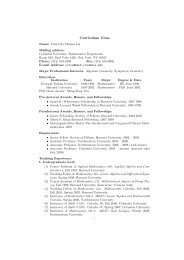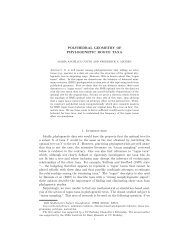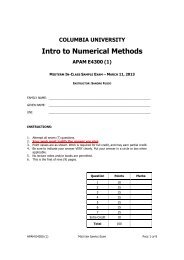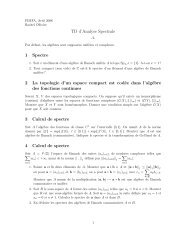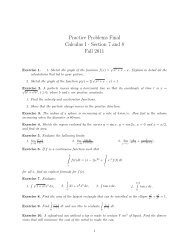INJECTIVES Contents 1. Introduction 1 2. Modules ... - Stacks Project
INJECTIVES Contents 1. Introduction 1 2. Modules ... - Stacks Project
INJECTIVES Contents 1. Introduction 1 2. Modules ... - Stacks Project
You also want an ePaper? Increase the reach of your titles
YUMPU automatically turns print PDFs into web optimized ePapers that Google loves.
6 <strong>INJECTIVES</strong><br />
This means in particular that there is some β ′ < α such that f factors through the<br />
submodule Mβ ′(N), as<br />
f : a → Mβ ′(N) → Mα(N).<br />
However, by the fundamental property of the functor M, see Lemma 3.7 part (3),<br />
we know that the map a → Mβ ′(N) can be extended to<br />
R → M(Mβ ′(N)) = Mβ ′ +1(N),<br />
and the last object imbeds in Mα(N) (as β ′ + 1 < α since α is a limit ordinal). In<br />
particular, f can be extended to Mα(N). <br />
4. G-modules<br />
Lemma 4.<strong>1.</strong> Let G be a topological group. The category ModG of discrete Gmodules,<br />
see Étale Cohomology, Definition 57.1 has functorial injective hulls.<br />
Proof. By Section 2 the category Mod Z[G] has functorial injective embeddings.<br />
Consider the forgetful functor v : ModG → Mod Z[G]. This functor is fully faithful,<br />
transforms injective maps into injective maps and has a right adjoint, namely<br />
u : M ↦→ u(M) = {x ∈ M | stabilizer of x is open}<br />
Since it is true that v(M) = 0 ⇒ M = 0 we conclude by Homology, Lemma<br />
2<strong>2.</strong>5. <br />
5. Abelian sheaves on a space<br />
Lemma 5.<strong>1.</strong> Let X be a topological space. The category of abelian sheaves on X<br />
has enough injectives. In fact it has functorial injective embeddings.<br />
Proof. For an abelian group A we denote j : A → J(A) the functorial injective<br />
embedding constructed in More on Algebra, Section 39. Let F be an abelian sheaf<br />
on X. By Sheaves, Example 7.5 the assignment<br />
I : U ↦→ I(U) = <br />
x∈U J(Fx)<br />
is an abelian sheaf. There is a canonical map F → I given by mapping s ∈ F(U)<br />
to <br />
x∈U j(sx) where sx ∈ Fx denotes the germ of s at x. This map is injective, see<br />
Sheaves, Lemma 1<strong>1.</strong>1 for example.<br />
It remains to prove the following: Given a rule x ↦→ Ix which assigns to each point<br />
x ∈ X an injective abelian group the sheaf I : U ↦→ <br />
x∈U Ix is injective. Note that<br />
I = <br />
x∈X ix,∗Ix<br />
is the product of the skyscraper sheaves ix,∗Ix (see Sheaves, Section 27 for notation.)<br />
We have<br />
MorAb(Fx, Ix) = Mor Ab(X)(F, ix,∗Ix).<br />
see Sheaves, Lemma 27.3. Hence it is clear that each ix,∗Ix is injective. Hence the<br />
injectivity of I follows from Homology, Lemma 20.3.



